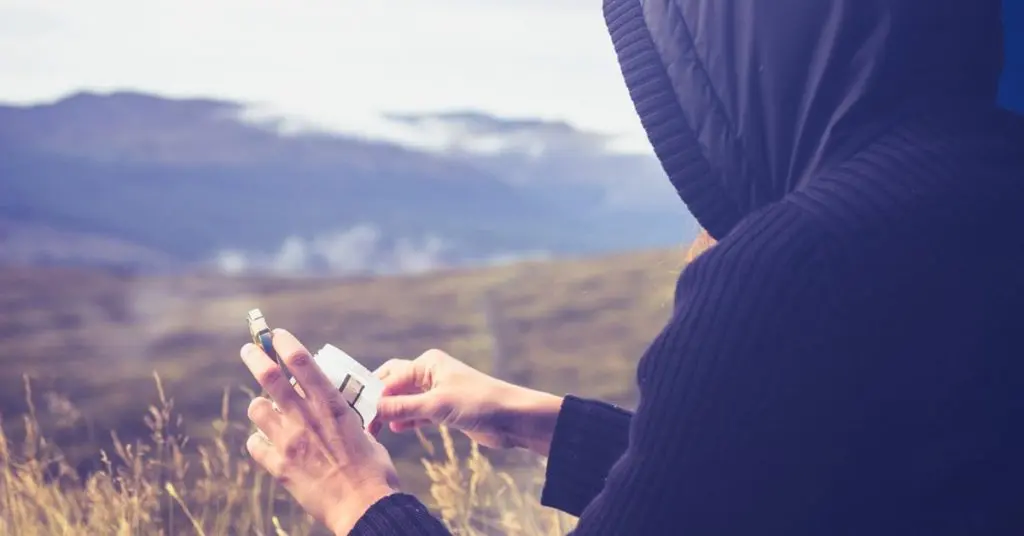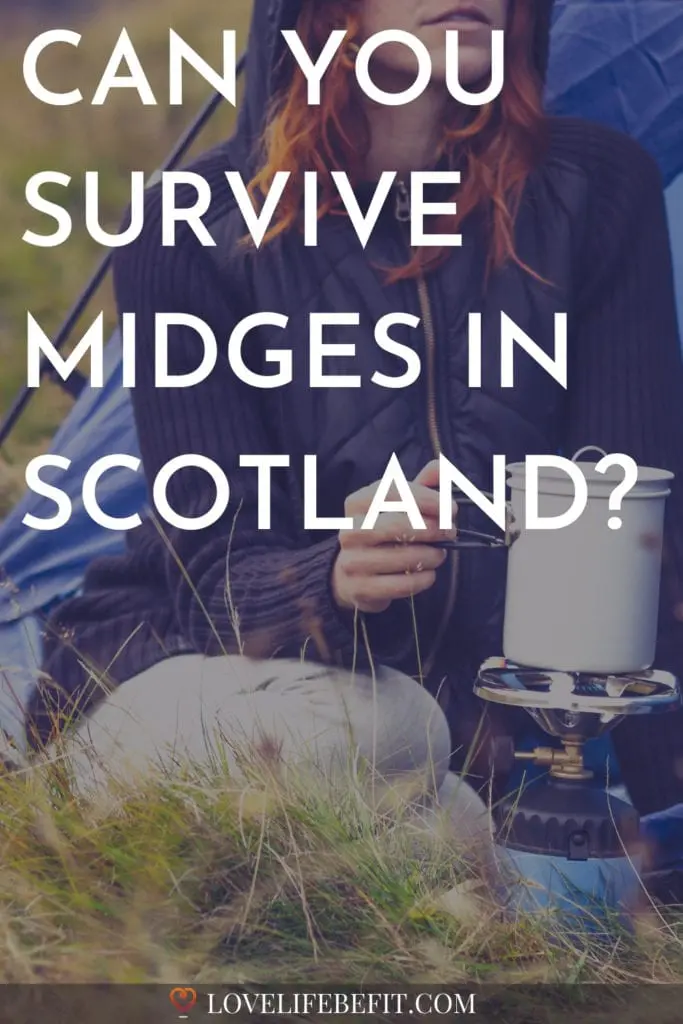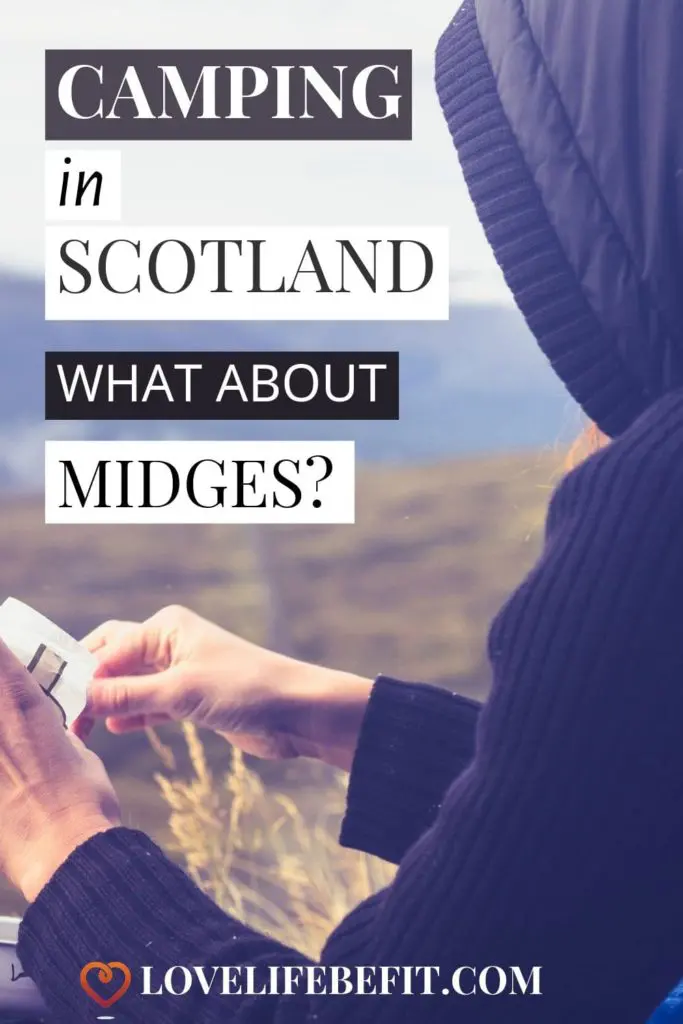“Camping in Scotland! In summer? What about the midges?”
I have a rule about midges in Scotland and we were just about to break it. My rule is I”ll camp in Scotland in early summer but not in the Scottish midge season.
The midge season in Scotland is between the end of May and around mid-September. Even as an outdoor lover, there are limits and the Scottish midge is mine.
Except on this occasion, my guy persuaded me to break the rule. We headed up to Fort William and camped ready to climb Tower Ridge on Ben Nevis the following morning. The midges were ferocious…
This review is based on my own independent product knowledge and testing. If you like what I do, you can support me through my chosen links. I may earn a commission but it’s at no additional cost to you. Learn more about my product recommendations.

✅ Warning if you can’t avoid traveling to Scotland in the midge season of June to September. Always go prepared. I never travel there without a good supply of this.
What Are Midges?
In case you’ve never heard of the Scottish midge, midges are tiny little things. They have a wingspan of only 2-3 mm. For such small little critters, they have a nasty bite.
Apparently not all varieties of midges bite and the male of the species don’t bite at all. It’s just the females and the most ferocious of the females is the Culicoides impunctatus. Otherwise known as the Highland Midge.
Getting bitten by something just 2mm long? That doesn’t sound so bad…
Haha! I’m not talking about being bitten by just ONE midge. I’m talking about being attacked by thousands. Midges swarm…
These little creatures can reduce grown men to tears. If you’re squeamish, don’t watch this video…
What Time Of Year Do Midges Come Out?
So now you know what I’m talking about. It’s not one little bite. It’s thousands of little bites I worry about.
If you want to avoid midges it’s best to visit Scotland in the spring, autumn, or winter when the midge larvae take cover a few centimeters below the soil surface.
The non-biting males emerge in early May but it’s not until late May/early June that the females start to swarm. My rule is that May is the best time to visit Scotland. Better weather and it’s still midge-free.
But that leaves the rest of the Summer when the weather can be terrific for walking and climbing but you’re scared off by a tiny 2 mm insect.
Where Are The Midges In Scotland?
In short, the answer is everywhere, but I’ve lived on the East Coast and not really noticed them. You do get midges on the East Coast of Scotland but they don’t swarm. It’s nowhere near as bad as the West Coast.
The best place to avoid midges in Scotland is in the cities or in the mountains.
You see midges need soil to lay their eggs, (they love peaty soil), and they’re too tiny to cope with a breeze. You can avoid them by staying high in the mountains during the day and spending the nights indoors.
They also hate sunshine. Go to Scotland in a heatwave and even the Highlands will be largely midge-free.
Heading to Scotland after a warm damp spring, in humid conditions with cloud cover and no breeze, is just asking for trouble.
So why was I breaking my no camping in Scotland in summer rule?
How Do You Avoid Midges?
You can avoid midges, even when you’re camping in peak midge season. We were camping in possibly the worst location, right below Ben Nevis where the midges were sheltered by trees. There was no wind.
The key to survival was being organized.
We camped right next to the car. The tent went up in seconds. Putting a tent up in a swarm of midges is not the time to have to get the instructions out.
✅ We wore midge protection gear. That means covering every possible inch of flesh with clothing and using a midge hood. Fortunately, the jaws of midges are too small to bite through clothes.
✅ Spraying ourselves with Avon Skin So Soft. It’s the local’s secret weapon against midges. I think it’s the smell they don’t like (a lovely citron perfume). This stuff helps but it won’t work miracles. Smidge Midge repellent is also a good midge deterrent.
Cooking and soaking up the atmosphere was out of the question. We’d eaten earlier in Fort William. The tent was zipped up tight keeping the inner midge free.
Make sure your mosquito mesh has holes small enough to keep out midges before you use it!
In the morning the midges were just as bad. The tent was quickly taken down and thrown into the back of the car. We breakfasted inside with the windows and doors tightly shut.
Tips For Avoiding Midge Bites
These are my top tips for avoiding midge bites:
- If you’re camping cover up from head to toe and use a midge hood to protect your face.
- Use midge repellent. It’s not a magical solution but it does help. See my suggestions below.
- Avoid dark clothing. Midges just love dark colors.
- Stay inside (or in your tent) on still evenings.
- Climb high during the day. You’re unlikely to encounter midges in the mountains.
- Keep moving. Midges don’t fly very fast so you can easily outwalk them.
Treating Midge Bites
For most people, midge bites are annoying but not dangerous and clear up very quickly. A few people are allergic and can have impressive reactions. (I have a cousin whose face swelled up from midge bites on a trip to the Isle of Skye).
✅ If you’re concerned find a doctor but in most cases, the reaction will subside using anti-histamine cream. I never travel without a good supply and find it helps to apply some as soon as you’re bitten. Aloe vera gel, tea tree oil, or lavender can also help soothe the itching.
Being attacked by a swarm of midges is stressful and unpleasant but the bites are harmless. Midges don’t pass on any disease.
Midge Repellent
I always take midge repellent with me on trips to Scotland in summer. Sometimes it works and sometimes the midges seem to just laugh at you and ignore it. It’s as if different strains of midges are affected by different repellents. More research is needed!!!
I’m not a fan of using DEET products. DEET may work but do you really want this stuff on your skin just for midges? I might use DEET to deter malaria-carrying mosquitos but not harmless midges.
These are my top midge repellent choices:
Avon Skin So Soft
This is the top choice of locals and the product I was recommended to use when living in the highlands. I find it helps. Avon Skin So Soft has a wonderful scent that midges just can’t stand. I’ve read it also works against mosquitoes, ticks, and horseflies.
It started as a lotion product to make your skin soft and just happened to work to repel midges. Avon finally realized why they were selling so much of the lotion and brought out an insect-repellent version. You can even get a longer-lasting expedition version!
It’s totally harmless to use and great for your skin. Essential packing if you’re walking the West Highland Way!
Smidge
It’s always good to have more than one option and Smidge can be very effective. Just like Avon Skin So Soft it’s perfectly safe to use and suitable for adults, children over 30 months, and pregnant women.
This stuff is long-lasting, up to 8 hours, and sweat-resistant. Billed as the UK’s No. 1 midge repellent, it’s also good for mosquitoes, horse flies, sand flies, fleas, and ticks.
Midge Hoods
If you intend camping in the summer in Scotland, a midge hood is essential. They’re also a good idea to take with you walking.
Midge hoods are small and light to carry – between the months of May and September you never know when you might need one!

Was It Worth Running The Gauntlet Of The Midge?
It was a spur-of-the-moment trip. We were only camping because in summer Scotland is full. Yes literally. There was no chance of getting affordable accommodation in Fort William at short notice.
It was a choice of camp or stay at home.
Yes, it was a bit testing avoiding the dreaded midge. But sometimes you have to take the rough with the smooth. Offset a little discomfort against the chance to climb a classic ridge.
Seizing the day and enjoying one of Scotland’s finest routes, part scrambling, part climbing with solid holds, scary exposure, and a real sense of adventure.
Did we remember the midges as we topped out in the mist just below the summit of Ben Nevis, Scotland’s highest mountain? No way! (In case you’re wondering there were no midges on the climb despite it being still, damp and warm).
Yes, Scotland has midges, but it also has so much else to offer. Don’t let a tiny 2 mm creature turn you away!
Midges, Scottish clegs (horseflies), and the dreaded ticks are all part and parcel of a trip to Scotland. I’d hate them to be a reason for you to stay away. Visit the cities or climb high during the day and stay inside from dusk until dawn… Have you experienced the Scottish midge?


